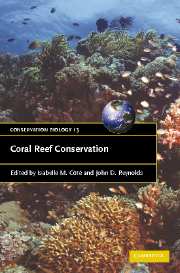Book contents
- Frontmatter
- Contents
- List of contributors
- Foreword
- Preface
- Part I Setting the stage
- Part II Uses and abuses: ecological and socio-economic issues
- Part III The way forward: tools and approache
- 9 New approaches to estimating recent ecological changes on coral reefs
- 10 Assessing the effectiveness of marine protected areas as a tool for improving coral reef management
- 11 Environmental impact assessment for coral reefs: advocating direct protective approaches
- 12 Time for a third-generation economics-based approach to coral management
- 13 Collaborative and community-based conservation of coral reefs, with reference to marine reserves in the Philippines
- 14 Education as a tool for coral reef conservation: lessons from marine protected areas
- 15 Adaptive institutions for coral reef conservation
- 16 Coral reef restoration with case studies from Florida
- 17 Redesigning coral reef conservation
- 18 Coral reef coda: what can we hope for?
- Index
- Plate section
- References
9 - New approaches to estimating recent ecological changes on coral reefs
Published online by Cambridge University Press: 05 June 2012
- Frontmatter
- Contents
- List of contributors
- Foreword
- Preface
- Part I Setting the stage
- Part II Uses and abuses: ecological and socio-economic issues
- Part III The way forward: tools and approache
- 9 New approaches to estimating recent ecological changes on coral reefs
- 10 Assessing the effectiveness of marine protected areas as a tool for improving coral reef management
- 11 Environmental impact assessment for coral reefs: advocating direct protective approaches
- 12 Time for a third-generation economics-based approach to coral management
- 13 Collaborative and community-based conservation of coral reefs, with reference to marine reserves in the Philippines
- 14 Education as a tool for coral reef conservation: lessons from marine protected areas
- 15 Adaptive institutions for coral reef conservation
- 16 Coral reef restoration with case studies from Florida
- 17 Redesigning coral reef conservation
- 18 Coral reef coda: what can we hope for?
- Index
- Plate section
- References
Summary
INTRODUCTION
Things are getting worse. Few conservation biologists would dispute this statement, but one of the major obstacles to understanding exactly how poorly nature is faring is the paucity of data on trends in the state of natural habitats, particularly at the global scale (Balmford et al., 2003). Jenkins et al. (2003), for example, were able to derive annual rates of change in aerial extent for only four of the nine natural habitats they considered. Of these, tropical forests, mangroves and seagrass beds have declined globally in area in the past decades, although the data for the latter two are not robust. Measuring the rate of change, either in the extent or state of habitats and ecosystems, is important for several reasons. First, rate of change is an indicator of ecosystem health that is easily understood by the public and decision-makers, and hard figures that are statistically robust can be used in conservation lobbying and advocacy. Second, measuring rates of change in natural habitats permits a quantitative assessment of the effectiveness of conservation interventions and environmental policies. Third, establishing trends in rates of change allows us to put current rates of change into context. This can be important, for example, when assessing whether we are likely to reach goals such as the target set by the Convention on Biological Diversity to reduce the rate of biodiversity loss by 2010 (UNEP, 2003; Balmford et al., 2005).
- Type
- Chapter
- Information
- Coral Reef Conservation , pp. 293 - 313Publisher: Cambridge University PressPrint publication year: 2006
References
- 9
- Cited by



